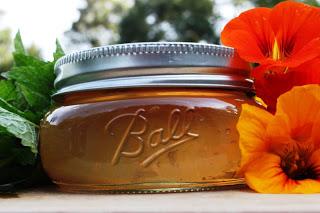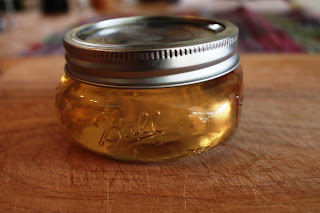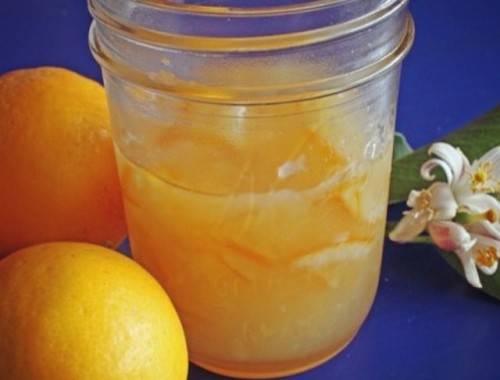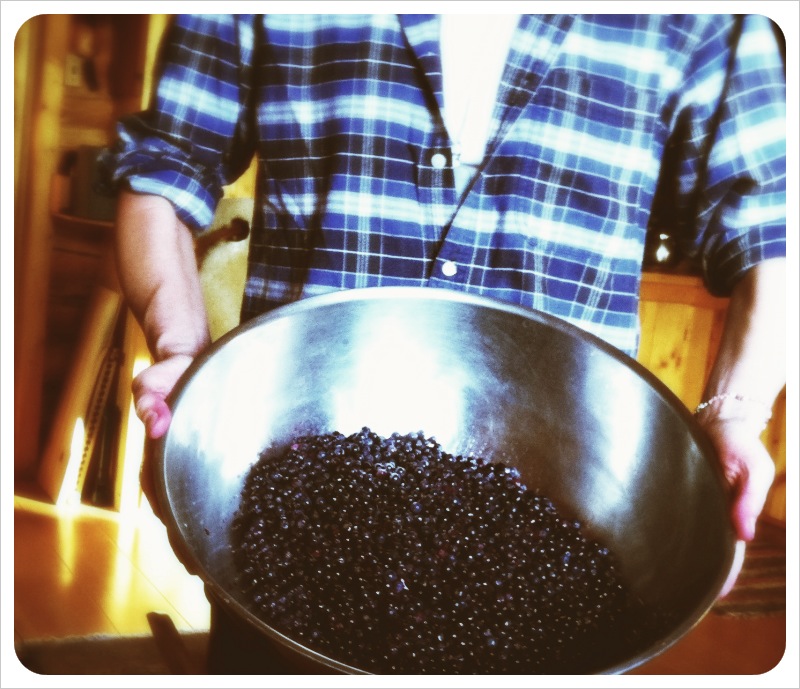A few weeks ago, I promised Stewart I’d make leg of lamb for his birthday in May. I’ve got a lot of learning to do, because the only thing I know about preparing leg of lamb is that what you put on it is mint jelly. But the mint jelly part? I’m all over it.
In a happy coincidence, the April Can Jam challenge was herbs, including flowers. All I had to do was step outside my kitchen door to spot the combination I wanted . . .
My nasturtium wasn’t blooming yet, but a quick trip to Berkeley’s bayside microclimate fixed me right up.
This was my first try at suspending flowers in a jelly. I’d been inspired by a gorgeous photo of rose petal jelly in which the rose petals were delicately lofted and distributed evenly throughout the jar. Of course now I can’t remember where I saw that picture — I may even have dreamed or imagined it. I didn’t have much luck with the even distribution thing. This is how I would grade my efforts on this jelly:
Flavor: A- (It tastes really good, but you’ve always gotta leave some room for improvement, right?)
Jell: A (I couldn’t have wanted a better set.)
Artful suspension of flowers: Um . . . do you see any flowers held delicately aloft in that jar?
I’ll say a little more about my experiment with adding blossoms below, but first, here’s the jelly recipe. I made it by combining a number of sources: the basic mint jelly recipe from the Ball Blue Book, some elements from “Apple Jelly with Rose Petals” from Mes Confitures, and my own ideas about nasturtium — and it works with or without the flowers. For a really nice, simple mint jelly, just leave them out.
Apple Mint Nasturtium Jelly
3 1/2 pounds granny smith apples
6 1/2 cups water, plus 1 cup for mint infusion
1 cup tightly packed mint leaves
2 tablespoons lemon juice
3 cups sugar
1/4 teaspoon spearmint extract (optional)
A dozen or so nasturtium flowers
1. Wash the apples and cut them into quarters without peeling or coring. Put them into your heavy-bottomed, nonreactive pot and add 6 1/2 cups water. Bring to a boil and simmer 1/2 hour on low heat. The apples will be soft and pulpy. (I took this poor photo of my apples at night, but I’ll tell you, they were gorgeous. Crisp and bright green without a blemish on them. I’ve learned the hard way that perfect is exactly how you want your apples to be. If they’re not, you’re asking for trouble with flavor and set.)
2. Strain the mixture through a boiled jelly bag or layers of cheesecloth that you’ve doused in boiling water and wrung out. This will take several hours, at least. (Don’t push the mixture through the bag, or you’ll muddy the jelly.) After you have the juice, quickly strain it a second time (again through a scalded, clean jelly bag or cheesecloth) to catch any straggling pulp. Pour the juice into a bowl and refrigerate it overnight.
3. The next day, begin by preparing the mint infusion. Add 1 cup of boiling water to the mint leaves. Steep them for an hour, mushing them every now and again to extract maximum flavor. (When it was ready, I strained my mint infusion through cheesecloth, too, so I could get the clearest jelly possible.)
4. Scooping the apple juice from the top of the bowl to avoid any sediment on the bottom, measure 4 1/2 cups juice into your clean pot. Add 1/2 cup of the mint infusion, the lemon juice, and the sugar. Bring the mixture to a boil and cook it to the jelling point.
5. Remove the mixture from the heat and skim off any foam. Immediately ladle the hot jelly into sterilized jars, layering a few nasturtium flowers into the top of each jar so that they’re just covered with a layer of jelly.
5. Seal the jars and process. I left 1/4 inch head space and processed five minutes in a water bath canner. Yielded 4 half-pints.
That’s it for the recipe. But now, about those flowers . . .
What I Learned About Adding Flowers to Jelly
I turned my kitchen into a floral science lab for this month’s Can Jam, and really appreciated the opportunity to play with something brand new. As you can see below, none of my half-pints of jelly look anything alike. To settle on the method I liked best (the one pictured and described above), I tried something different with each jar.
First, I tried to follow the advice from Mes Confitures that suggests you can put flowers or petals into your jars, seal them, then wait until the jelly is almost cool before you gently shake the jars “so the petals distribute themselves attractively.” Not so much. At least not for me. I ended up with a gelatinous clump of unidentifiable flower matter stuck to one side of the jar. I transgressed from “gently shaking” to all manner of disturbing maneuvers, which is how the jar below ended up on its head. It wasn’t pretty.
I also read somewhere that that letting the jelly cool just a little in the pan, adding flowers, and then filling the jar would ruin the texture of the jelly. I confirmed that this is true. The jelly in the jar below is unevenly textured and full of air bubbles. The flowers are visible and they’re somewhat intriguing, but not necessarily appetizing . . .
For me, the winning option was definitely the method I described in the recipe, gently laying the flowers on top of the jelly before sealing the jar and then leaving well enough alone. That means the flowers will be there — surprise! — when you open the lid, but otherwise the jelly looks just like a clear jewel:
Finally, I couldn’t resist doing one jar the old fashioned way: Straight-up mint with no flowers and a tiny drop of green food coloring:
Enough said, though I could have gone on and on taking photos of nasturtium and mint. The colors!
Happy spring!
















